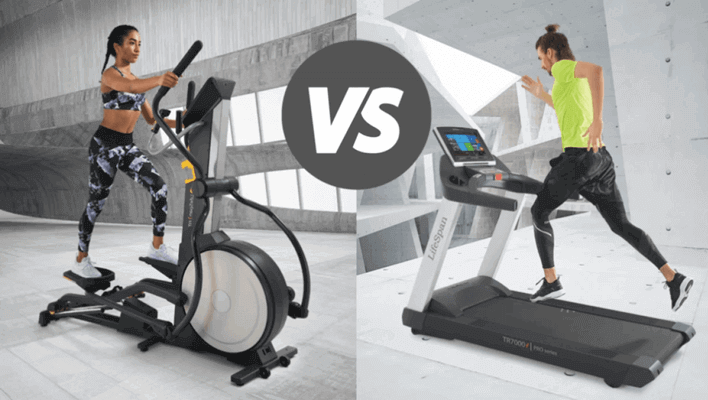Treadmills have been the preferred fitness machine for more than a century. When elliptical cross trainers first became available 20 years ago, the fitness community was split on which was better: elliptical or treadmill.
Both forms of equipment will assist you in keeping your cardiovascular system in good condition. But, in terms of cardio training, which one gets you the most bang for your buck? Continue reading to learn more.
Elliptical Trainer vs. Treadmill
We’ll go through the advantages and disadvantages of each type of equipment in this article so you can decide which is best for you. Let the conflict begin!
The Treadmill’s History
The treadmill was invented by the Romans in the first century AD, long before the concept of training equipment became popular.
Treadmills were formerly used as a form of punishment in jails in the 1800s, ironically. So they have to be decent, right?
The first ‘workout’ treadmill was patented in 1913, but the first machine did not hit the market until the late 1960s.
It is now the industry standard in both commercial and residential gyms across the world.
The Elliptical Cross Trainer’s History
The first elliptical, created in the mid-1990s, was large and took up a lot of space.
Users were able to keep their entire foot in contact with the ‘pedal’ platforms throughout the movement thanks to an incorporated flywheel. This motion was comparable to that of an exercise bike, but it was done standing up and with a jogging-like knee movement. It resembled a hybrid of a treadmill and a stationary bike.
When it was initially introduced in 1995, the Precor Elliptical Fitness Cross Trainer was the first commercial Elliptical marketed as “zero impact” training equipment.
Early elliptical machines offered low-impact exercise that reduced muscle and joint pounding. Users of the elliptical machine, on the other hand, reported less felt exertion than treadmill users.
Standard Features of Both Machines
Both types of fitness equipment have a few basic features in common. As the price of the system rises, many of these functions become more complicated and capable.
Display
The display is the most common component of both types of cardio machines. On the main console in front of you, almost every treadmill and elliptical machine features an LCD or LED display.
Some consoles feature large flat surfaces where a book, magazine, or iPad tablet can be safely placed. On a treadmill, the display is situated across the two handles, whereas on an elliptical, it is mounted above the flywheel.
Some are bigger and have more features and capabilities.
Each display will (at the very least) calculate your time, speed, and distance during each session.
More modern machines include additional features, such as calculating how many calories you’re burning and monitoring your heart rate.
Sound System
As you go up the ladder of increasingly complex gadgets, the opportunity for a superb sound system develops. Speakers for listening to music from your smartphone or other audio devices are included in the basic computers.
With the introduction of wireless headphones, however, this feature is less important because you can listen to your music without dangling cables or irritating people nearby.
Cooling Fan
This is another feature that most laptops in the mid-range and higher price ranges have as standard. The complexity, model, and price of these fans are frequently determining factors in their performance.
When you start sweating, these fans usually provide a variety of options and settings.
Heart Rate Monitor
Except for the cheaper machines, all machines offer this feature. The equipment you buy determines the location and quality of the heart rate sensors.
On treadmills, heart rate sensors are always near the grips. A pair of sensors are located just beneath the display in many versions, with a second set on the sidebars.
You wrap your hand around the sensors and use your hands to grip the reading surface.
Elliptical machines will also include two sensors in the grips of the moving arms.
For both, the current heart rate is displayed on the screen. For people who want to keep track of their workout progress and enhance their cardiovascular fitness, this is a must-have tool.
So you’ll be able to see if it’s growing easier over time or distance.
Treadmill vs. Elliptical Cross Trainer: What’s the Difference?
Both are fixed training machines made of plastic and metal. The basic hardware and monitoring systems are the only similarities between an elliptical cross trainer and a treadmill.
The physics of how each cardio machine works produce a completely different workout.
You should examine and analyze these operational differences before making your ultimate decision.
Unique Features and Benefits of Treadmills
Unless it is a simple manual model, the treadmill will have a motor. The belt is driven by this motor, and you jog at a set speed. Some versions will even adjust the incline for you automatically.
You have the option of manually configuring these two settings or using a pre-programmed program that will switch them throughout the workout.
The horsepower rating of a motor shows the machine’s maximum speed and, in most circumstances, its long-term durability. Once again, you get what you paid for.
The running deck of a treadmill has a spinning belt. The proportions of this belt are extremely important. Larger machines take up more room, but they offer a larger and more stable running surface.
A set of arms can be found on each side of the treadmill. Larger computers are more likely to offer more assistance. These sidebars are especially appealing to the elderly and those recovering from injuries.
Unique Features and Benefits of the Elliptical Cross Trainer
At this point, the most significant differences between these two pieces of training equipment will become clear. An elliptical trainer does not possess a motor.
Instead of a motor-driven belt on which you walk or run, the elliptical has two platforms or steps for your feet.
You use a complex network of arms and moving joints to move your legs in a walking motion, while also holding hand grips that move in time with the footsteps.
The magnetic resistance of the flywheel can be changed to make each step more or less demanding.
Your feet will never leave the foot platforms. The motion of an elliptical cross trainer is similar to that of an exercise bike and treadmill running.
Your feet are kept secure by the foot platforms. As a result, your joints will be less hammered, and you’ll be less likely to injure yourself by tumbling off a treadmill belt.
You also don’t have to maintain a certain speed, like you would on a treadmill. You can set the elliptical pedals and arms to move at your own pace.
Maintaining a consistent intensity during your workout becomes more difficult as a result.
Differences Between a Treadmill and an Elliptical Workout?
Here are some of the differences between the two devices in terms of the parts of the body they work on.
Keying on Your Calves
Your lower legs will replicate the same foot roll as running or walking on level ground when you walk, jog, or run at full speed on a treadmill. Your calves will have to put in the same amount of effort as you.
It’s nearly impossible to achieve the same level of intensity for your calves on an elliptical machine.
While the elliptical stride’s stair rising motion will aid calf growth, you won’t be able to achieve the same intensity as you would on a treadmill because you won’t have to bend your foot and lift it off the platform.
The Arm Element
This is where a treadmill workout differs from an elliptical workout.
Running from the waist up on a treadmill provides minimal benefit.
Arm workouts can be done at walking speed, but you’ll most likely need to slow down.
To overcome this, some users wear weights on their hands; nevertheless, this can be difficult for certain people.
Elliptical machines have moving handles. The pushing and pulling movement on the moving handles targets your arms. Your arms, chest, and shoulders will feel the effects as well.
Easy on your joints
Consider how each machine functions, and you’ll realize why this is the most significant distinction between the two.
While the cushioning on treadmill decks has greatly increased, you are still replicating a portion of the same pounding motion.
Even the best shoes can’t protect you from the mechanics of impact.
When you workout on an elliptical, you have less impact on your ankle, knee, and hip joints. It may take some time to become used to the motions, but the elliptical cross trainer’s decreased gravity impact is what makes it easier on your joints.
This gain, according to others, comes at the expense of fewer calories expended and poorer functionality. You’ll have to weigh this trade-off before making your decision.
Conclusion
When deciding on a winner in the cardio battle between an elliptical cross trainer and a treadmill, the several elements we’ve discussed must be taken into account.
Treadmills should be a high priority if you want to focus on training certain leg muscles for hiking, jogging, and especially competitive running.
A treadmill is the only way to simulate the exact muscle movement required to train for any of these sports. If space is a constraint, the notion of a foldable treadmill can be very appealing.
For persons with serious joint difficulties, starting with an elliptical machine is an excellent approach. The Elliptical has a reduced impact on your joints and a simpler workout, which is the most significant difference between these two types of exercise equipment.
The majority of treadmill manufacturers, on the other hand, encourage a range of deck cushioning strategies. There are clever shock absorbers beneath the running deck that help to reduce the impact when your feet land on the running belt. Both will get your heart rate up, and both are better than sitting on the couch.
So, what are you waiting for? If you believe a treadmill would be right for you, take a look at some of our most recent treadmill reviews.
Recommended Posts:
10 Best Treadmills Under $1,000 in 2021 – Reviews & Buying Guide
10 Best Budget Treadmills – Reviews & Buying Guide
12 Best Treadmills for Walking – Reviews & Buying Guide

Being a certified fitness coach and instructor for years now, I am well aware of the exercises guaranteed to improve a person’s fitness and physique. I am a big advocate of regular exercise and want everyone to understand how important it is. For this purpose, I strive to educate people through my writing, how they can become fit using the right equipment and techniques.
